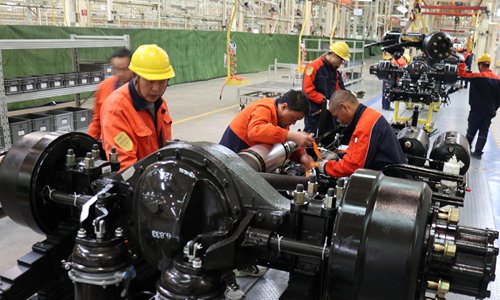HOME >> BUSINESS
China's CPI, PPI difference set to widen in August
By Wang Yi Source:Global Times Published: 2019/9/9 22:48:40
Stimulus measures can stabilize growth, offset weak demand: analysts

File photo: VCG
The difference between China's consumer price index (CPI) and producer price index (PPI) is expected to widen in August, showing the relatively weak demand in the overall economy, according to analysts.
But China's economic growth is expected to remain stable as more stimulus measures will start to take effect in the third quarter, they said.
China's National Bureau of Statistics (NBS) is set to issue the CPI and PPI data for August on Tuesday. Chinese analysts on Monday predicted that the growth of CPI might climb further while PPI will continue to drop.
The overall CPI is expected to see a modest uptick, mainly driven by surging prices of pork and related food prices, Wang Zuli, a research fellow with the Chinese Academy of Agricultural Sciences, told the Global Times on Monday.
China's CPI rose by 2.8 percent in July, according to NBS data, the largest rise since February 2018.
In August, pork prices rose faster than in the previous few months, and prices of eggs and other meat also rose, Wang said, adding that food accounts for about 30 percent of the overall CPI, with pork accounting for about 2-2.5 percent.
Given that the tight supply of pork has not been improved, the escalating China-US trade tension has increased agricultural costs to some extent, so CPI will climb further, analysts said, but it will be mild and controllable, and will not squeeze the room for China to launch monetary policies to stabilize the economy.
The impact of the trade war on CPI will be at most 0.1-0.2 percentage points in August, Wang Xiaosong, an economics professor at the Renmin University of China in Beijing, told the Global Times on Monday.
The rise of several particular products' prices will not cause a dramatic rise in the overall CPI, Liu Xuezhi, an economist at Bank of Communications, told the Global Times on Monday.
The price rises of non-food products, which account for about 70 percent of overall CPI, still remain weak, which shows the relatively weak domestic demand, Liu said.
China's PPI, an indicator of selling prices for domestic production, fell by 0.3 percent year-on-year in July, the biggest drop since the 0.8 fall recorded in August 2016. The PPI is expected to continue to drop in August, analysts said.
The PPI in July was dragged down by production goods and in the short term the downward trend is likely to continue, Liu said. "But as more support policies to boost consumption and infrastructure construction kick in, the PPI is expected to pick up and remain stable," Liu noted.
Support measures including cuts in the reserve requirement ratio (RRR) will start to take effect, and issuance of local debt will efficiently stabilize the economy, said Tian Yun, a vice director of the Beijing Economic Operation Association.
Indicators like the CPI and PPI need to be seen from a different perspective during the key period of transforming to an innovation-driven quality growth model, Yuan Fuhua, director of the economic growth office of the Chinese Academy of Social Sciences, told the Global Times on Monday.
China's economy has shown great resilience amid the impact of an escalating trade war, Yuan noted.
Newspaper headline: CPI, PPI difference set to widen in August
Posted in: ECONOMY